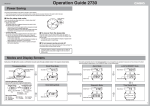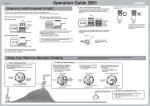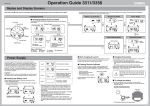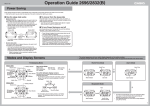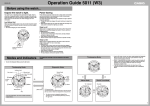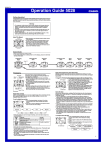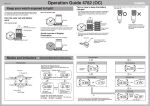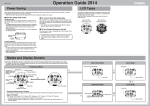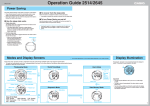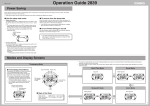Download Casio 4343 Watch User Manual
Transcript
Operation Guide 4343 MA0804-EG Before using the watch... Expose the watch to light Power Saving Your watch runs on electrical power generated from light and stored by a chargeable battery. Long-term storage of the watch can cause the battery to run low, so be sure to expose the watch to light for some time before using it for the first time. See “Solar Charging” for more information. Power Saving causes the watch to enter a sleep state automatically and stop movement of the analog hands in order to save power whenever it is left in the dark. The watch will exit the sleep state if you expose it to light or perform any button operation. • Note that the watch may also enter the sleep state and stop if it is blocked from light by your sleeve. Low Battery Alert When secondary battery power is low, the second hand of the watch will start to jump at 2-second intervals to let you know that charging is required. • See “Low Battery Alert” for more information. How the sleep state works Sleep Level 1 The display sleep state is triggered whenever the watch is left in the dark for about one hour between the hours of 10 p.m. and 6 a.m. • The second hand stops. • The hour and minute hands, and the date indicator continue to operate normally. • Alarms and the hourly time signal continue to operate normally. 30 Sleep Level 2 Sleep Level 2 is triggered whenever the watch is left in the dark while in Sleep Level 1 for six or seven days. • The hour and minute hands, and the date indicator stop at their current positions. • Auto Receive is disabled. • Alarms and the hourly time signal are disabled. • Digital timekeeping functions continue to operate normally. Jumps 2 seconds Modes and Indicators You can use the button operations shown below to enter the Timekeeping Mode, World Time Mode, or Alarm Mode directly. Chronograph Mode Timekeeping Mode Second Hand Button Button (Chronograph Mode) Hour Hand (24-hour) Chronograph Hands (Hour, Minute) • The indicator hand points to the city code. • World Time lets you display the current time in any one of 27 cities (29 time zones) around the world. Minute Hand Hour Hand • Start • Stop • Reset World Time Mode Indicator Hand City Code (New York) Button Second Hand (Moving) 1/20-second Hand (First minute only.) Use the button to scroll clockwise through the city codes around the face. 30 30 30 ❚ To search for a city code World Time (Hour, Minute) Button Date ❚ To check the reception result The stopwatch performs 1/20-second elapsed time measurement up to 23 hours, 59 minutes, 59.95 seconds (24 hours). Start/Stop Press the button to start and stop the chronograph. Chronograph Reset To exit the Chronograph Mode, the chronograph must be reset by pressing the button while the chronograph is stopped. The chronograph is reset when the second hand, chronograph hands, and 1/20second hand are all at 12 o’clock. (While chronograph is reset.) Press the button. The indicator hand will move to “Y” (successful) or “N” (unsuccessful) to indicate the reception result. Alarm Mode Y: Successful ON = On OFF = Off N: Unsuccessful ❚ To turn the alarm on or off ❚ To trigger a receive operation manually Hold down the button for about two seconds until the indicator hand moves to the “READY” position. This will start signal reception. • The indicator hand points to ON or OFF. • Use this mode to set the alarm time and to turn the alarm on or off. Alarm Time (Hour, Minute) Press the button to toggle the alarm on and off. 30 • On/Off For more information, see “How a Radiocontrolled Watch Works”. 1 Operation Guide 4343 How the solar cell and battery work Solar Charging When exposed to light Your watch runs on electrical power generated from light and stored by a chargeable battery. To ensure stable operation, make sure that the watch is exposed to light as much as possible. • Whenever you are not wearing the watch on your wrist, position it so the face (solar cell) is pointed in the direction of a source of bright light. Light Solar cell (Converts light to power.) • When wearing the watch, try to keep your sleeve from blocking its face, where the solar cell is located. Charging Precautions Avoid charging the watch in the following locations, and anywhere else where the watch may become very hot. • On the dashboard of an automobile parked in the sun • Very close to an incandescent light source or other sources of heat • In a location exposed to direct sunlight for long periods Electrical Energy Depending on the light source you are using, the case of the watch may become quite hot when charging. Take care to guard against burn injury after charging. Charge Solar Cell Rechargeable Battery Light Power supplied to watch When not exposed to light Leave the watch under fluorescent lighting, near a window, etc. Charging efficiency is reduced significantly even if the face of the watch is covered only partially by your sleeve. Rechargeable Discharge Battery Power supplied to watch Your watch continues to operate even when it is not exposed to light. Leaving the watch in the dark can run down its battery and cause functions to become disabled. Low Battery Alert Charging Guide When secondary battery power is low, the second hand of the watch will start to jump at 2-second intervals to let you know that charging is required. • Required Charging Time for One Day of Operation Based on six minutes of signal reception and 10 seconds of alarm per day. Normal Operation Low Battery Alert Disabled State Hands stop at 12 o’clock. If power drops even more... When battery runs low 30 1 1 Home Position The second, hour, and minute hands all stop at 12 o’clock. Jumps 1 second. Jumps 2 seconds. At midnight, the date indicator will change to 1 (which is the home position). Important! The following functions are disabled when battery power is low. • Auto receive and manual receive • Alarm beeper • Even if the battery level drops to the point that timekeeping stops, you still will be able to recharge the battery and use the watch again. • When you recharge the battery after it drops to a level where timekeeping stops, the hands will move automatically to the current time setting. • Try to keep the watch exposed to light as much as possible during normal use. Exposure Level (Brightness) Charging Time Outdoor Sunlight (50,000 lux) 8 minutes Sunlight through a Window (10,000 lux) 30 minutes Overcast Daylight through a Window (5,000 lux) 48 minutes Indoor Fluorescent Lighting (500 lux) 8 hours Making sure the watch is exposed to light ensures stable operation. • Approximate Charge Times Required to Advance to a Higher Level Exposure Level (Brightness) Charging Time Until Hand Movement Until Full Charge Restarts Outdoor Sunlight (50,000 lux) 1 hours 21 hours Sunlight through a Window (10,000 lux) 2 hours 77 hours Overcast Daylight through a Window (5,000 lux) 4 hours ––– Indoor Fluorescent Lighting (500 lux) 35 hours ––– • Note that the above charging times are for reference only. Actual charging time depends on a variety of environmental factors. 2 Operation Guide 4343 How a Radio-controlled Watch Works Receiving the Calibration Signal There are two methods you can use in order to receive the time calibration signal. What is a radio-controlled watch? Calibration Signal Auto Receive A radio-controlled watch is designed to receive a time calibration signal that contains standard time data and adjust its current time setting accordingly. • The Japanese calibration signal (Call Sign: JJY) is maintained by the National Institute of Information and Communications Technology (NICT). It is transmitted 24 hours a day from the Mt. Otakadoya transmitter (40 kHz) located in Tamura-gun, Fukushima Prefecture, and from the Mt. Hagane transmitter (60 kHz) located on the border between Saga Prefecture and Fukuoka Prefecture. • The U.S. calibration signal (Call Sign: WWVB) is transmitted by the National Institute of Standards and technology from Fort Collins, Colorado. • Time calibration signal frequencies and transmitter locations are subject to change. Up to six times per day (Midnight, 1:00, 2:00, 3:00, 4:00, and 5:00 a.m.) • As soon as one auto receive is complete, all subsequent auto receives for that day are cancelled. Transmitter Signal is received by built-in antenna. Long-wave time calibration signal Signal data Watch decodes received data and converts it to time data. Decode Cesium atomic clock Time data Watch Internally Time is adjusted according to time data. After the watch receives the Standard Time signal, it performs internal calculations to determine the current time. Because of this, there may be an error of up to one second in the displayed time. The time data of the Japanese calibration signal (Call Sign: JJY) is maintained by the Japan Standard Time Group of the National Institute of Information and Communications Technology (NICT). Note that transmission of the standard wave may be interrupted occasionally due to maintenance, lightning, etc. For more information, visit the website of the Japan Standard Time Group of the National Institute of Information and Communications Technology (NICT) at the following URL. Manual Receive You initiate signal reception by pressing a button. • The indicator hand will indicate the result of the reception, the watch will beep, and the indicator hand will move to “READY”. In the Timekeeping Mode, press the A button to renter the Receive Result Mode, which displays the last receive result. • The indicator hand will move to “Y” (if the last reception was successful) or “N” (if the last reception was unsuccessful). • Press the A button to return to the Timekeeping Mode. • The watch also will return to the Timekeeping Mode automatically if you do not perform any operation for about five seconds. Remove the watch from your wrist and place it somewhere so its top (12 o’clock, where the antenna is located) is facing approximately in the direction of the signal transmitter. Keep it away from metal objects. • The indicator hand will move to “WORK”. • The hour and minute hands will remain at their normal positions. • Do not perform any watch operations while signal reception is in progress. Y: Successful N: Unsuccessful 30 READY WORK ❚ To interrupt a receive operation Press any button. WORK When reception is complete (Signaled when the watch beeps.) • When the receive operation is successful, the indicator hand moves to “Y”, the watch adjusts its time, and then the indicator hand returns to its second hand operation after about one or two minutes. • When the receive operation fails, the indicator hand moves to “N” and then the watch returns to the unadjusted time after about one or two minutes. Reception Ranges This watch is designed to receive the standard time calibration signal of Japan (JJY) or of the United States (WWVB). The signal that is received depends on the current Home City setting. • For information about selecting a Home City, see “Changing the Home City Setting”. See the “World Time City Code List” for information about city codes. Home City (Supports signal reception) TYO, HKG Resin Band While reception is in progress 30 http://jjy.nict.go.jp ❚ To position the watch for optimum reception • The indicator hand will move to “READY”. • The hour and minute hands will remain at their normal positions. • The second hand will stop at “0”. Hold down the A button for about two seconds. • Note that the above URL is subject to change. ❚ To check the result of the last receive operation At the start of the receive operation Receivable Transmitter Either the Mt. Otakadoya signal (40 kHz) or the Mt. Hagane signal (60 kHz) HNL, ANC, LAX, DEN, CHI, NYC Ft.Collins • Signal reception is possible in Hong Kong (HKG), Honolulu (HNL), and Anchorage (ANC) when reception conditions are good. Y: Successful N: Unsuccessful 1000km Transmitter Location Transmitter Location 30 Metal Band The last receive status changes each time a new time calibration signal receive operation is performed. • Orienting the watch so it is sideways to the transmitter makes it more difficult to receive the signal. • Do not move the watch while it is receiving the calibration signal. Time Required for Reception Signal reception normally takes anywhere from about two to seven minutes. Under certain signal conditions however, the receive operation can take as long at 14 minutes. 500km Mt. Hagane (60 kHz) 500km Mt. Otakadoya (40 kHz) 1000km 3000km Ft.Collins 1000km Certain conditions can make reception impossible even when the watch is within one of the reception ranges shown above. Signals become weaker outside of the smaller circles indicated by dashed lines, so the reception environment has a greater effect on signal reception. • The following also can affect signal reception: geographic contours, structures, weather, climate, time of day (afternoon, evening), noise. 3 Operation Guide 4343 Location Reception is difficult and may even be impossible in the locations described below. Avoid such locations when performing signal reception. • You should think of your watch as operating like a radio or TV when it is receiving the calibration signal. Among or near buildings Inside a vehicle (automobile, train, plane, etc.) In a location where there is radio interference (construction site, airport, etc.) Near high-voltage lines Next to a household appliance or office equipment (TV, speaker, fax, computer, cell phone, etc.) Calibration Signal Reception Precautions Troubleshooting • Auto receive is disabled while the watch is in the Chronograph Mode. • Operating any button while auto receive is in progress will cause the watch to beep and then exit the receive operation. • Make sure you are within the range of a calibration signal transmitter before performing the receive operation. Remember that geographic contours, nearby buildings, the season, or the time of day can make reception impossible even when you are within range of the transmitter. • Proper reception may be impossible if there is something blocking the signal. If reception is unsuccessful, try again. • This watch is designed to adjust its current time setting in accordance with the calibration signal transmitted in Japan and the United States only. Note that you will need to make your own adjustments when using this watch outside of Japan or the United States, or in any area that is outside the range of one of the receivable time calibration signal transmitters. • When the watch is unable to adjust its time using the calibration signal for some reason, timekeeping accuracy is within ±20 seconds per month. • Strong electrostatic charge can cause timekeeping error. • Receive is cancelled if an alarm operation starts while it is being performed. • The watch’s calendar shows dates up to the year 2099. Attempting a receive operation after that causes an error. 1. The watch cannot receive the time calibration signal. • Is there something in the immediate area that may be interfering with reception? Even if you are within the reception range of a transmitter, objects between you and the transmitter or electrical noise can interfere with reception. Avoid such areas during signal reception. See “Location” for more information. • Are you within the reception range of a transmitter? See “Reception Ranges” for information about areas where the watch can receive the signal. • Do you have the correct Home City code selected? Remember that auto receive is not performed unless TYO (Tokyo), HKG (Hong Kong), NYC (New York), CHI (Chicago), DEN (Denver), LAX (Los Angeles), ANC (Anchorage), or HNL (Honolulu) is selected as the Home City. Select the correct Home City code using the procedure under “Changing the Home City Setting”. • Is the signal being transmitted? Though the time data of the Japanese calibration signal (Call Sign: JJY) is maintained by the Japan Standard Time Group of the National Institute of Information and Communications Technology (NICT), it sometimes may be interrupted for periodic maintenance work, or because of lightning or other problems. 2. Time calibration signal reception is successful, but the hourly time signal and current time are slightly off. • After the watch receives the time calibration signal, it performs an internal decoding process before updating its time setting. Because of this, the time setting may be off slightly (within one second). 3. Time calibration signal reception is successful, but the current time setting is wrong. • Is the correct city code selected for your Home City? Select the correct Home City code using the procedure under “Changing the Home City Setting”. Near mountains If you are experiencing problems with reception, move away from the types of locations described above to a location with better reception, and try again. Using the Chronograph The chronograph performs 1/20-second elapsed time measurement up to 23 hours, 59 minutes, 59.95 seconds (24 hours). When the maximum limit is reached, the elapsed time returns to zero automatically and timing continues from there. ❚ To start or stop an elapsed time operation Enter the Chronograph Mode to use the chronograph. • In the Timekeeping Mode, press the B button once to enter the Chronograph Mode. Timekeeping Mode Second • Start • Stop • Reset Chronograph Mode Indicator hand makes one revolution. Hour, Minute 30 1/20 second 30 30 Start Second hand counts seconds. Second hand moves to “0”. • To return to the Timekeeping Mode, press the A button while the chronograph is reset to zero. Stop Reset • 1/20-second timing is performed for the first minute after you start or restart an elapsed time measurement operation. The 1/20second hand also jumps to the elapsed time position when you stop an elapsed time measurement operation. • Pressing the A button while an elapsed time measurement operation is in progress resets the chronograph to zero. Cumulative Time Measurement Pressing the B button to restart the chronograph without resetting it to all zeros resumes elapsed time measurement from where it was last stopped. 4 Operation Guide 4343 ❚ To check the current summer time on/ off setting Using World Time World Time lets you display the current time in any one of 27 cities (29 time zones) around the world. • Press the D button to enter the World Time Mode. • If you are entering from the Chronograph Mode, the chronograph must be reset first. See “Chronograph Reset” for more information. World Time Mode In the World Time Mode, press the A button. ❚ To search for a city In the World Time Mode, press the D button to move the indicator hand (which is pointing at the currently selected city code) clockwise. (Indicates zone) • About one second after you release the D button, the hands of the watch will move to the current time in the zone of the indicated city code. Currently Selected City Code • The second hand moves to “0” when summer time is turned on, and to “5” (between “4” and “6”) when summer time is turned off. • The second hand will resume normal operation after about five seconds. 30 (Clockwise) Current time in the zone where the currently selected city code is located (24-hour format; hour, minute) Indicator Hand 30 Home City beep indicator Time City Code Zone (Hour, Minute) If the city code that the indicator hand moves to when you press the D button is your currently selected Home City, the watch will beep. Important! If the current time shown of the selected city code is not correct, check the current time setting of your Home Time and make adjustments as necessary. • For information about configuring home time settings, see “Changing the Home City Setting”. 30 ❚ To turn summer time on or off 1. In the World Time Mode, use the D button to select the city code whose summer time setting you want to change. 2. Hold down the A button for about five seconds to toggle summer time on or off. • You can turn summer time on or off individually for each World Time city. Note, however, that you cannot change the summer time setting for the “GMT” (Greenwich Mean Time) zone. Off When summer time is turned on • When you turn on summer time for a city code that supports time calibration signal reception, the watch will decide automatically whether or not to apply the summer time or standard time setting in accordance with the received signal. • In the case of a city code that does not support signal reception, turning on summer time advances the current time setting by one hour. • City codes that support signal reception are TYO, HKG, HNL, ANC, LAX DEN, CHI, and NYC. • Signal reception is possible in Hong Kong (HKG), Honolulu (HNL), and Anchorage (ANC) when reception conditions are good. • To select summer time manually for a city code that supports signal reception, turn off summer time for the city code and then select a city code in the neighboring time zone that will advance the time by one hour. 30 OFF (5 seconds) 30 ON Summer time, or Daylight Saving Time (DST) as is it is called in some countries, calls for setting clocks ahead one hour during the summer season. Note that the use of summer time depends on the country and even the local area. • Press the B button to return to the Timekeeping Mode. Changing the Home City Setting Use the World Time Mode to specify your Home City. Example: To change the Home City setting from New York (NYC) to Tokyo (TYO) 1. In the World Time Mode, use the D button to select the city code you want to use as your new Home City. Current Time in Selected City 30 TYO Selected 2. Hold down the A button as you press the D button to swap your current Home City with the World Time City you selected in step 1. • The watch will beep and make the currently selected World Time City your new Home City. • Your previous Home City will become your new World Time City, and the indicator hand will move to its city code. Indicator Hand Movement 30 Important! If you are using the watch in Japan, be sure to select TYO (Tokyo) as your Home City. Selecting another city code will make it impossible to receive the time calibration signal, which will cause your time setting to be off. World Time City Code List City GMT DifferCode ential City Name City GMT DifferCode ential City Name GMT +0.0 Greenwich Mean Time ADL +9.5 LON +0.0 London SYD +10.0 Adelaide Sydney PAR +1.0 Paris NOU +11.0 Noumea ATH +2.0 Athens WLG +12.0 Wellington JED +3.0 Jeddah PPG –11.0 Pago Pago THR +3.5 Teheran HNL –10.0 Honolulu DXB +4.0 Dubai ANC –9.0 Anchorage KBL +4.5 Kabul LAX –8.0 Los Angeles KHI +5.0 Karachi DEN –7.0 Denver DEL +5.5 Delhi CHI –6.0 Chicago New York DAC +6.0 Dhaka NYC –5.0 RGN +6.5 Yangon *CCS –4.0 Caracas BKK +7.0 Bangkok RIO –3.0 Rio de Janeiro HKG +8.0 Hong Kong –2.0 TYO +9.0 Tokyo –1.0 • Based on data as of June 2007. • The rules governing global times (GMT differential and UTC offset) and summer time are determined by each individual country. * In December 2007, Venezuela changed its offset from –4.0 to –4.5. Note, however, that this watch displays an offset of –4.0 (the old offset) for the CCS (Caracas, Venezuela) city code. 5 Operation Guide 4343 ❚ To set the alarm time Using the Alarms Example: To change the alarm setting from midnight to 3:00 p.m. The watch beeps for 10 seconds when the Timekeeping Mode time reaches the currently set alarm time. • The alarm will sound when the current time in your Home City matches the alarm time. • Press the C button to enter the Alarm Mode. • If you are entering from the Chronograph Mode, the chronograph must be reset first. See “Chronograph Reset” for more information. 1. ❚ To turn the alarm on or off In the Alarm Mode, press the C button to toggle the alarm on and off. • When the alarm is turned on, a beeper sounds when the alarm time is reached. OFF In the Alarm Mode, hold down the A button for about five seconds until the indicator hand moves to “ON” and the second hand moves to zero. ON When everything is the way you want, press the A button to exit the alarm setting mode. • This will exit the alarm setting mode and the second hand will resume normal operation. • The watch will exit the alarm setting mode automatically if you do not perform any button operation for about two or three minutes. 30 • This indicates the setting mode. 3. 30 ON 0 Alarm Mode ON or OFF 2. 30 30 ❚ To stop the alarm Pressing any button while the alarm is sounding stops it. • To return to the Timekeeping Mode from the Alarm Mode, press the B button. Note that you cannot return to the Timekeeping Mode while in the alarm setting mode. 4. Setting the Time and Date Manually You can perform the following procedures to adjust the time and date when the watch is unable to receive a time calibration signal for some reason. 1. In the Timekeeping Mode hold down the A button until the indicator hand completes the following sequence of operations: indicates the last signal reception result, moves to the “READY” position, moves to 12 o’clock. • This is the setting mode. • Keep A button depressed until the indicator hands stops at 12 o’clock. • The second hand also will move to “0” at this time. Indicator Hand 30 Second Hand 2. Use the D (+) and B (–) buttons to change the hour and minute setting. 24-hour Hand Hour, Minute (–) • Each press of either button changes the setting by one minute. 30 • Holding down either button will cause the hands to move Date Hour, at high speed. Once started, Minute (+) high-speed hand movement (+) will continue even if you release the button. To stop high-speed hand movement, press any button. • When setting the time, make sure you also watch the 24-hour hand so the time is set properly (1:00 a.m. = 1 o’clock, 1:00 p.m. = 13 o’clock). 3. Alarm time • Each press of either button changes the setting by one minute. • Holding down either button will cause the hands to move at high speed. Once started, high-speed hand movement will continue even if you release the button. To stop high-speed hand movement, press any button. • The alarm time uses 24-hour timekeeping format. 30 Alarm Setting (24-hour Format) Use the D (+) and B (–) buttons to change the alarm setting in oneminute increments. (–) 30 (+) When everything is the way you want, press the A button to exit the setting mode. • The second hand will resume normal operation. • Pressing A to restart timekeeping on a time signal on the TV or radio ensures precise setting. • The watch will exit the setting mode automatically if you do not perform any button operation for about two or three minutes. 30 When you are using the watch in an area that supports time calibration signal reception, it will adjust the date automatically for month lengths and leap years. If you use it in an area that does not support signal reception, you will have to make adjustments for month lengths and leap year manually. Use the C button to change the day setting. • Each press of the C button advances the day by one. 6 Operation Guide 4343 3. Home Position Adjustment If the time setting of your watch is not correct even though time calibration signal reception is being performed normally, use the procedure in this section to check the home positions of the hands and make adjustments as required. Note that you do not need to perform the following operation if your watch is showing the correct time. 1. In the Timekeeping Mode, hold down the A button and then the C button for about five seconds. 2. • The watch will beep, and then the indicator hand and the second hand will move their home positions. Home Position Indicator Hand: 12 o’clock Second Hand: 0 30 Second Hand • If the indicator hand and second hand are both at their proper home positions, advance to step 3. 9. Check the day indicator. If it is not at its home position, use the C button to move it there. 1 Home Position Day 1 Day • If the Day is at its proper home position, advance to step 9. If the Day is not at its proper home position 8. Use the D (+) and B (–) buttons to adjust the day. 1 Press the C button. Home Position Hour Hand: 24:00 Minute Hand: 24:00 • If the hour and minute hands are at their proper home positions, advance to step 7. If the chronograph hour and minute hands are not at their proper home positions 4. 30 Chronograph Hands 30 30 If the chronograph hour and minute hands are not at their proper home positions 6. Use the D (+) and B (–) buttons to adjust the hands. 30 • Holding down either button will cause the hands to move at high speed. Once started, high-speed hand movement will continue even if you release the button. To stop high-speed hand movement, press any button. • The 24-hour hand is synchronized with the hour and minute hands, so separate adjustment is not required. 7. 5. • This will cause the chronograph hour and minute hands to move to their home positions. • If the hour, minute, and 24-hour hands are all at their proper home positions, advance to step 5. Use the B button to adjust the position of the indicator hand and the C button to adjust the position of the second hand. • The hands move clockwise only. Keep pressing the buttons until the applicable hand is at its proper home position. • This will cause the hour hand, minute hand, and 24-hour hand to move to their home positions. Hour and Minute Hands 24-hour Hand Home Position Hour Hand: 12 o’clock Minute Hand: 12 o’clock 24-hour Hand: 24:00 If the indicator hand or second hand is not at its proper home position Indicator Hand Press the C button. Use the D (+) and B (–) buttons to adjust the hands. 30 • Holding down either button will cause the hands to move at high speed. Once started, high-speed hand movement will continue even if you release the button. To stop high-speed hand movement, press any button. Press the A button to exit home position adjustment and return to the Timekeeping Mode. • If you press the C button instead of the A button in step 1, the watch will return to step 1 (indicator hand and second hand home position adjustment) of this procedure. • The watch also will exit home position adjustment automatically if you do not perform any operation for about two or three minutes. 30 After completing the home position adjustment procedure, put the watch in a location where it is able to receive the time calibration signal easily and perform a manual receive operation. • For details about the manual receive procedure, see “Receiving the Calibration Signal”. • Holding down either button will cause the day to change at high speed. Once started, high-speed day change will continue even if you release the button. To stop high-speed day change, press any button. 7







